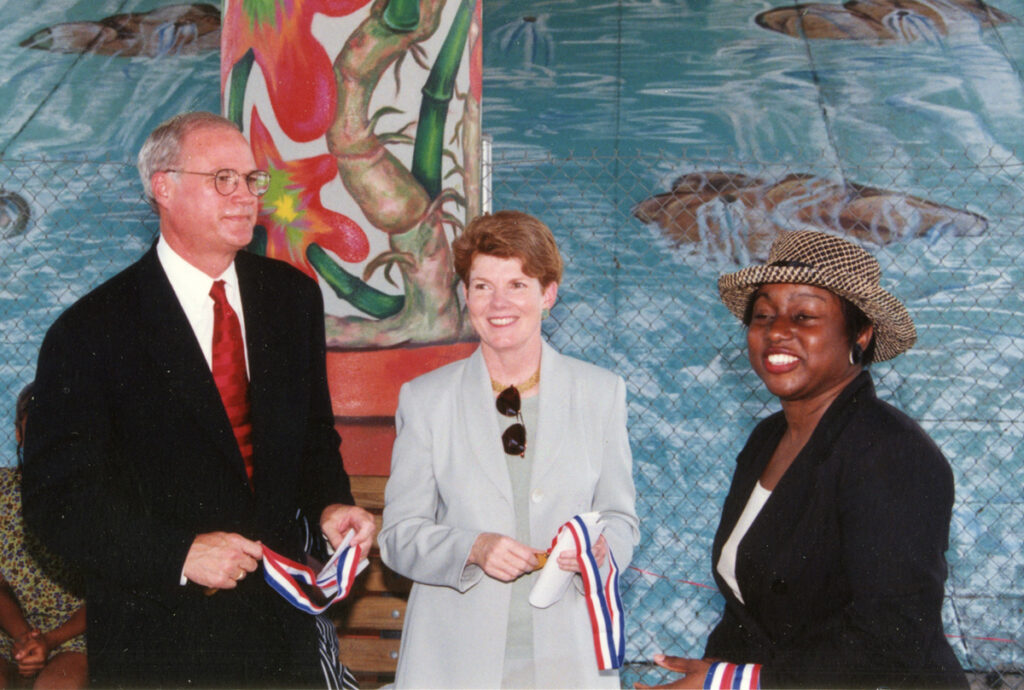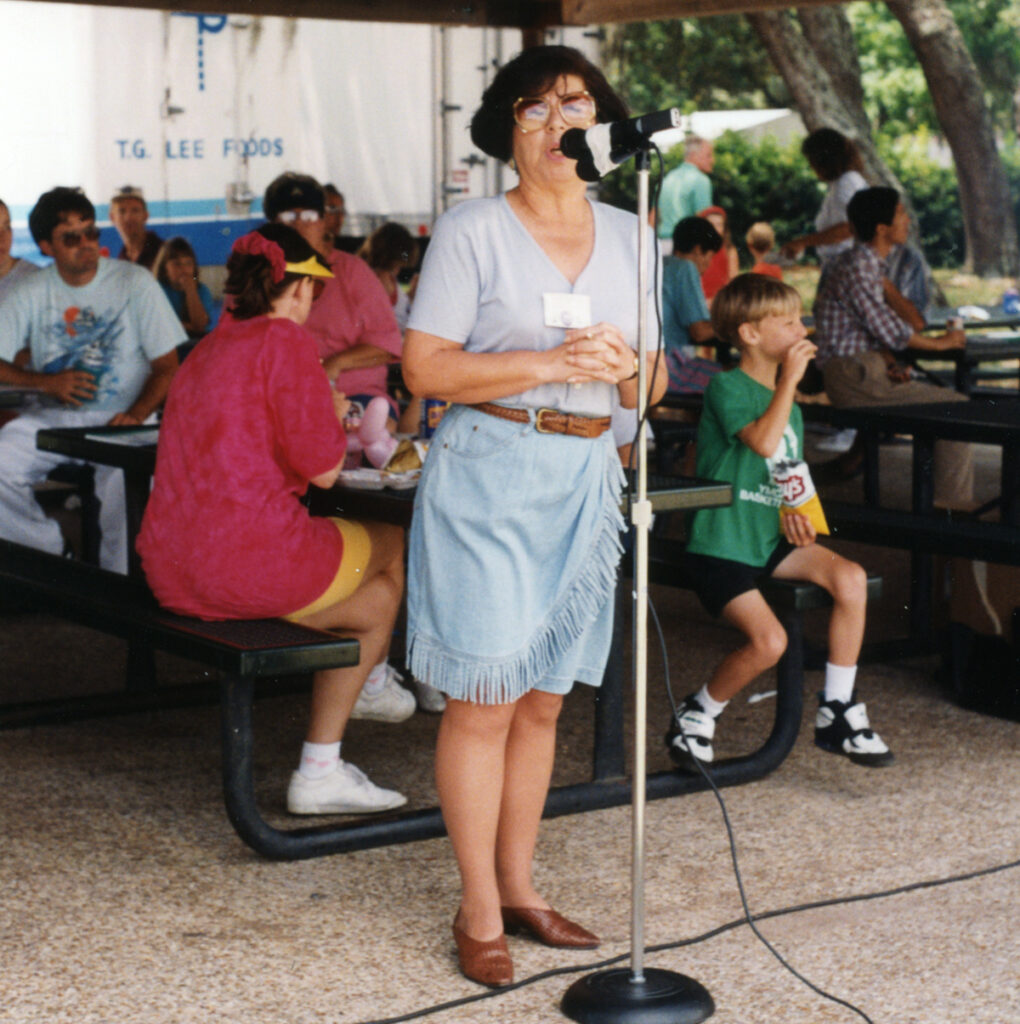By Adaeze Nwigwe, from the Spring 2024 Edition of Reflections Magazine
Magical, picturesque, and for a period phenomenal: all were descriptions that could be applied to the city of Orlando in 1908. Early migrants to the area such as Jessie Johnson Branch from South Dakota were enraptured by the verdant sights and the startling sounds of the bustling city – so much so that in 1908 she and her husband joined a competition to ascribe a more fitting name to the city. Her submission of “The City Beautiful” resonated with residents then just as it continues to do today. Branch’s story also illustrates another important tradition within Orlando, that of women being pivotal to honoring the city’s beauty.
Decades later, this legacy resonated in Orlando with later generations of women leaders. Among them were the familiar faces of former Orlando Mayor Glenda Hood and City Commissioner Mary I. Johnson (who was also an Orange County commissioner). Together these women upheld the motto through their many initiatives to improve our city and make it truly beautiful.
On June 30, 1988, then commissioners Hood and Johnson stood side by side with Mayor Bill Frederick to rededicate Lake Eola Park to the people of Orlando, solidifying their commitment of service to the city. Lake Eola Park was established as the city’s first public park in 1883 when Jacob Summerlin donated a portion of his land to the city. Since then, it has continued to be a popular area of recreation.
In the 1980s, however, the area surrounding Lake Eola Park became inundated with crime and a neglected homeless population. These conditions inspired local leaders like Hood and Johnson to participate in the area’s restoration in 1988. This effort for the park totaled $3.3 million and included increased security measures, an information booth to learn more about the city, and other eye-catching amenities.
The park had shared significance to both women, as it embodied “The City Beautiful” mission and their personal ties to this space. In a 1995 oral history interview, Hood described the park as her true childhood playground, a place where she and her family would go to watch the the landmark fountain change colors. Additionally, Johnson was a self-proclaimed “big park person” who enjoyed creating more open, green spaces for Orlando residents. The work to restore Lake Eola Park served as just one early example of both women’s life-long commitment to the Orlando community.

Hood: Deep roots in Orlando
A fourth-generation Central Florida native, Hood has always held Orlando close to her heart. She grew up in the area, attending Oak Ridge High School and then Rollins College, where she obtained a bachelor’s degree in Spanish literature. After settling into married life and motherhood, Hood became active in volunteering and from the start set her sights on improving the city of Orlando.
During one of Hood’s earliest positions with the Downtown Development Board, she created a walking tour and helped organize concerts. Hood continued to serve her community through her role as a city commissioner, as the first woman mayor of Orlando (1992-2003), and as Florida’s secretary of state (2003-2005). In a 1992 interview, Hood described her interest in politics as “a way to bring together my commitment to the community and my business skills and . . . be a part of making decisions for the future of this community.”
Armed with this philosophy, Hood employed numerous measures to beautify the city. Early in her tenure as Orlando’s mayor, she negotiated a partnership between a public and private entity to preserve a 26-acre parcel of land near the downtown area. She was able to persuade the private owners to retain ownership but allow the City of Orlando to maintain the property as a city green space. Moreover, she implemented the Mayor’s Neighborhood Matching Grants program in 1994, which provided Orlando’s neighborhood associations with grants for projects to improve the quality of life in certain communities. These projects included both external, aesthetic improvements such as entranceway beautification and internal improvements such as providing emergency response training to residents.
Other notable initiatives by Hood include her 1999 three-year plan in which $30 million was allotted “to increase Orlando’s green space from 735 to 1,000 acres.” She also planned for the number of parks to increase from 63 to 72. Hood used her position as a public servant to help the residents within Orlando especially in the downtown area, which she called “the signature of the city.”

Johnson: Newcomer who left a legacy
The downtown area proved significant not only for Hood but also for Johnson, who felt that “a healthy downtown is good for any city and area.” Like Jessie Johnson Branch decades earlier, Johnson was a migrant to Orlando who ultimately left a big impact. Originally from New York, she settled in Central Florida after her marriage to Navy Chief Petty Officer Robert “Bob” Johnson in 1954. She became involved in volunteering for organizations such as Navy Wives Club and the Red Cross, as a dental hygienist. This interest in public service continued to blossom in 1980 when she became the first person of Hispanic descent to be elected to Orlando City Council. She served three terms as a commissioner for District 2 from 1980-1992 and another three terms for District 3.
During this time, “The City Beautiful” was a motto Johnson took seriously, which is plainly seen through her multiple park initiatives. She participated in advocating for the creation of a park in predominantly Latin American communities such as Azalea Park, where she collaborated in the development of Azalea Park Field of Dreams. Like her colleague Hood, Johnson’s efforts for improvement were not limited to outside appearances. She supported those within her community as well, most significantly through her establishment of the Victim Service Center of Central Florida near downtown Orlando.
The Victim Service Center was created when Johnson realized the lack of services for survivors of crime. She rallied for funding and support through Orange County Government, and following a persistent effort, she was able to establish the center in 1999. The Victim Service Center functions to support community members at their most vulnerable through resources including legal advocacy, therapy, and a 24/7 crisis hotline.
A butterfly symbol can be seen on the organization’s website. Johnson frequently wore a butterfly pin on the back of her jacket as a personal representation of hope and a new beginning. She wanted all those who visited the center to see it as a new start toward a safer, beautiful life. This desire to help those within the community can also be seen through her mentorship efforts. At Harry P. Leu Gardens, while introducing residents to the beauty of the space, she would annually host recruitment teas. An April 1999 Orlando Sentinel article described these meetings as “a forum for women to discuss and assess their status as leaders in government.”
In this way, Johnson demonstrated her eagerness to guide women dedicated to helping those in their communities. Current District 3 Commissioner Mayra Uribe described Johnson as “an amazing woman who inspired so many young girls, including me, to serve their communities.” Uribe recalled canvassing for Johnson’s campaign with her parents as a young child, and remembers Johnson telling her, “Always be respectful and earn respect.”
The spirit of collaboration, mentorship, and community continues to live on through the legacies of both Hood and Johnson’s service to the City of Orlando. Despite Johnson’s passing in 2020 and Hood’s retirement from public service, their steadfastness to Orlando’s creed can still be seen today. Lake Eola Park and other green spaces continue to be an expression of Orlando’s commitment to innovation and a community of beauty for all. The work of both women illustrates the resilience of women dedicated to making and keeping the city beautiful.
Adaeze Nwigwe was the Orange County Regional History Center’s HERstory intern for 2023.

